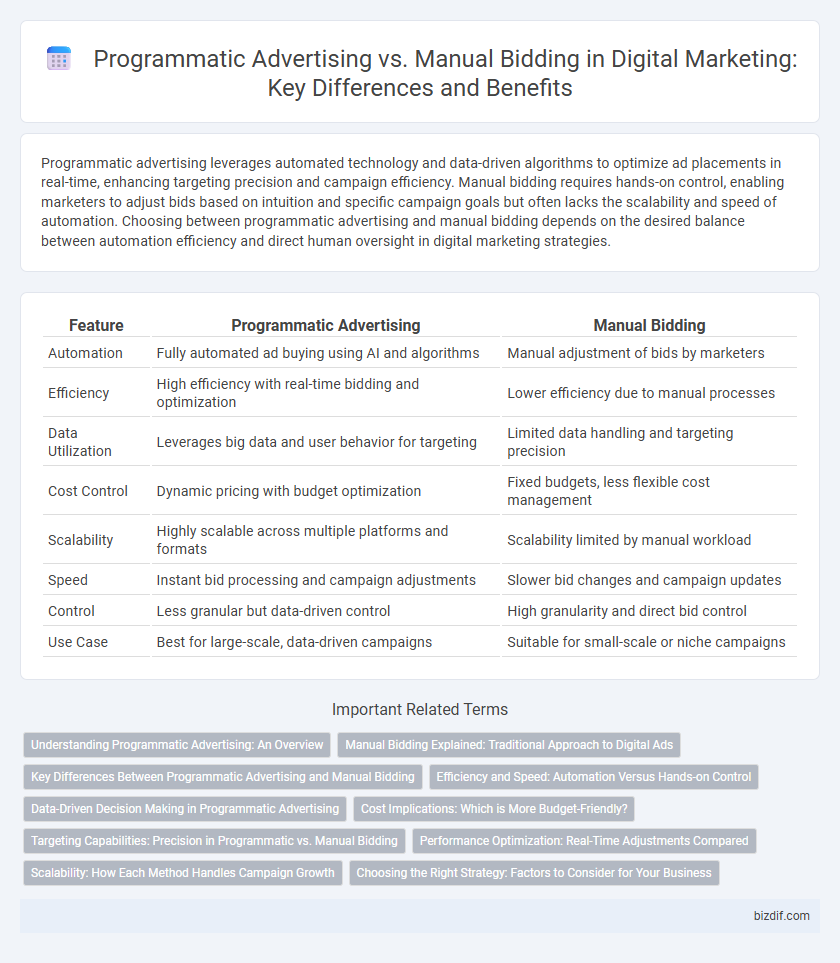Programmatic advertising leverages automated technology and data-driven algorithms to optimize ad placements in real-time, enhancing targeting precision and campaign efficiency. Manual bidding requires hands-on control, enabling marketers to adjust bids based on intuition and specific campaign goals but often lacks the scalability and speed of automation. Choosing between programmatic advertising and manual bidding depends on the desired balance between automation efficiency and direct human oversight in digital marketing strategies.
Table of Comparison
| Feature | Programmatic Advertising | Manual Bidding |
|---|---|---|
| Automation | Fully automated ad buying using AI and algorithms | Manual adjustment of bids by marketers |
| Efficiency | High efficiency with real-time bidding and optimization | Lower efficiency due to manual processes |
| Data Utilization | Leverages big data and user behavior for targeting | Limited data handling and targeting precision |
| Cost Control | Dynamic pricing with budget optimization | Fixed budgets, less flexible cost management |
| Scalability | Highly scalable across multiple platforms and formats | Scalability limited by manual workload |
| Speed | Instant bid processing and campaign adjustments | Slower bid changes and campaign updates |
| Control | Less granular but data-driven control | High granularity and direct bid control |
| Use Case | Best for large-scale, data-driven campaigns | Suitable for small-scale or niche campaigns |
Understanding Programmatic Advertising: An Overview
Programmatic advertising automates the buying and placement of ads using AI-driven algorithms, optimizing real-time bidding across multiple platforms for enhanced targeting precision. Unlike manual bidding, which requires marketers to individually manage bids and adjust campaigns, programmatic systems leverage vast datasets to deliver personalized ads at scale. This automation increases efficiency, reduces human error, and ensures ads reach the most relevant audience segments based on behavior, demographics, and contextual relevance.
Manual Bidding Explained: Traditional Approach to Digital Ads
Manual bidding in digital marketing refers to advertisers setting individual bids for ad placements, allowing greater control over spend and targeting compared to automated methods. This approach requires continuous monitoring and adjustments based on campaign performance metrics like click-through rates (CTR) and cost-per-click (CPC). Despite being time-intensive, manual bidding enables precise budget management and strategic targeting tailored to specific audience segments.
Key Differences Between Programmatic Advertising and Manual Bidding
Programmatic advertising automates ad buying using algorithms and real-time data, enhancing efficiency and targeting precision compared to manual bidding, which relies on manual input and human judgment. Programmatic leverages machine learning and audience segmentation to optimize bid placements instantly, while manual bidding involves direct control over unit bids and campaign adjustments by marketers. The key differences lie in scalability, speed, and data-driven decision-making, with programmatic providing a dynamic, automated approach versus the hands-on, slower process of manual bidding.
Efficiency and Speed: Automation Versus Hands-on Control
Programmatic advertising streamlines campaign management by using automated algorithms to optimize bids in real-time, significantly enhancing efficiency and speed. Manual bidding requires hands-on control, allowing marketers to fine-tune strategies but often delaying response times and reducing scalability. Programmatic systems handle large-scale data processing instantly, while manual bidding may be better suited for niche campaigns needing detailed oversight.
Data-Driven Decision Making in Programmatic Advertising
Programmatic advertising leverages real-time data analytics and machine learning algorithms to optimize ad placements and bidding strategies automatically, enhancing targeting precision and campaign performance. In contrast, manual bidding relies heavily on human intuition and periodic data review, often limiting responsiveness to market fluctuations and user behavior. Data-driven decision making in programmatic advertising empowers marketers to adjust bids dynamically based on audience insights, conversion rates, and contextual relevance, significantly improving ROI and reducing wasted ad spend.
Cost Implications: Which is More Budget-Friendly?
Programmatic advertising leverages automated bidding algorithms that optimize ad spend in real time, often reducing wasted budget and improving cost efficiency compared to manual bidding. Manual bidding requires continuous human intervention and market analysis, which can lead to higher operational costs and less precision in budget allocation. Businesses aiming for budget-friendly campaigns typically benefit more from programmatic advertising due to its ability to adjust bids dynamically based on performance data and audience targeting.
Targeting Capabilities: Precision in Programmatic vs. Manual Bidding
Programmatic advertising leverages advanced algorithms and real-time data to achieve high precision in audience targeting, optimizing ad delivery based on user behavior, demographics, and contextual signals. Manual bidding relies more on predefined parameters and human judgment, often resulting in less granular targeting and slower adjustment to market changes. The superior targeting capabilities of programmatic platforms enable marketers to maximize ROI by reaching the most relevant audiences efficiently.
Performance Optimization: Real-Time Adjustments Compared
Programmatic advertising leverages AI algorithms to execute real-time bidding adjustments, delivering highly optimized campaign performance through automated data analysis and audience targeting. Manual bidding relies on marketer expertise and periodic manual updates, which can delay response to market changes and potentially reduce optimization efficiency. Real-time adjustments in programmatic advertising enhance ROI by continuously aligning bids with performance metrics and competitive landscape dynamics.
Scalability: How Each Method Handles Campaign Growth
Programmatic advertising excels in scalability by leveraging AI-driven algorithms that optimize bids in real-time across multiple channels, enabling seamless campaign expansion with minimal manual intervention. Manual bidding requires continuous human oversight to adjust bids, making it less efficient and more labor-intensive as campaign volume increases. Businesses aiming for rapid growth benefit from programmatic's ability to handle large datasets and dynamic market conditions swiftly.
Choosing the Right Strategy: Factors to Consider for Your Business
Selecting between programmatic advertising and manual bidding depends on factors such as budget size, campaign scale, and desired level of control. Programmatic advertising offers real-time bidding automation and data-driven targeting, ideal for businesses seeking efficiency and scale. Manual bidding suits companies prioritizing granular control over ad placement and costs, often beneficial for niche markets or specific audience targeting.
Programmatic advertising vs Manual bidding Infographic

 bizdif.com
bizdif.com